This heritage walk information is available in a brochure, which is available from Quorn Railway Station.
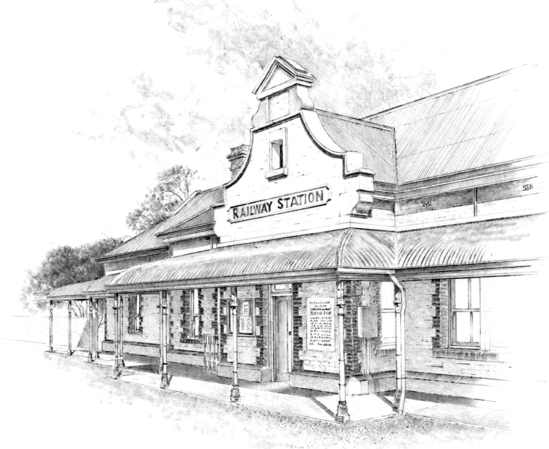
Quorn Railway Station has a significant if not colourful role in railway history in South Australia. It was planned as a railway junction for rail traffic travelling north-south and east-west across the continent and for the transport of minerals from the Flinders Ranges. The prospect of opening rich agricultural lands on the Willochra Plain was an added incentive. The Great Northern Railway, later known as the Central Australia Railway, reached Quorn from Port Augusta in 1879.
A cottage-style timber station building was erected in that year when the yards were also completed, although work continued on workmen’s cottages and railway water supplies into the 1890s. The old station was replaced by the present elegant stone and brick structure in 1916.
During the Second World War Quorn became a hive of activity in the movement of troops to Darwin in preparedness for a Japanese invasion, following the bombing in 1941. Troops, supplies, evacuees and stock moved continuously in and out of Quorn day and night. The Quorn Country Women’s Association offered to provide meals for troops and evacuees during their stops at Quorn, serving them either on the verandah, or in the army-built Sydney Williams hut, or in the First World War Memorial Hall on the Quorn Oval. Much appreciated freshly cooked meals for hundreds of people were provided sometimes at short notice. These were Quorn’s glory days.
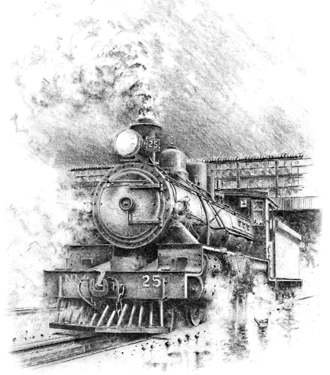
After the war railway business in Quorn waned especially after the completion of the new northern railway west of the Ranges in 1956. The line between Hawker and Quorn was maintained until 1970 to transport barytes from the Oraparinna mine to the treatment plant which is just north of the Quorn Railway Station Yard. Improved roads brought an end to use of the railway.
The Pichi Richi Railway Preservation Society was formed in 1973 following the efforts of a group of enthusiasts who pressed for the retention of the railway in Pichi Richi Pass between Quorn and Port Augusta. The Society now makes a major contribution to tourist experiences in the central Flinders Ranges, running and maintaining the railway and rolling stock. This includes the appealing little ‘Coffee Pot’, a steam rail coach which operated from 1906 to 1931 carrying goods and passengers, including sports teams, between Quorn and local towns.
SELF-GUIDED WALK: Allow 1 hour
START: At the Station building
LOOK OUT FOR TRAINS AT ALL TIMES.
You can also take a guided tour of the Pichi Richi Railway Workshops. Enquire at the Station or at the Visitor Information Centre in Seventh Street.
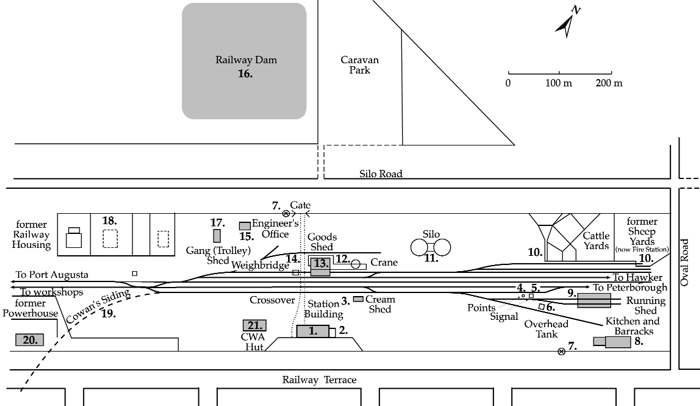
1. RAILWAY STATION BUILDING (Jan 1916)
Local stone and locally manufactured bricks were used for the new building which replaced the original timber one. The Dutch gables are a unique feature and the Resident Engineer, Frank Yeomans (who is believed to have been responsible for the design), may have decided to emulate the gable on a bank building at 6 Railway Terrace. Following much effort on the part of the Pichi Richi Railway Preservation Society, part of the Pichi Richi line was opened in 1974 as a tourist railway by the then Governor of South Australia, Sir Mark Oliphant. The Station is now managed by the Society.

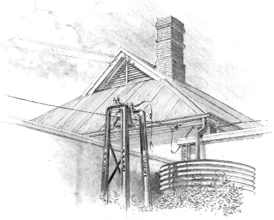
2. STATION BELL AND TELEPHONE LINE (date unknown)
Passengers needed to be aware that the train was about to depart and the bell summoned them to the Station. The Station telephone connected with the Overland Telegraph Line and messages from delayed trains could be sent by attaching hand pieces to overhead wires anywhere along the line. The whole of the Central Australia Railway was controlled by Quorn train control.
3. THE CREAM SHED (about 1920)
With wire mesh top and bottom of this shed, air was allowed to circulate to control the temperature inside. Perishable goods for despatch were stored here temporarily. After the 1930s when the butter factory (in Cowan’s old mill, see Item 19) closed, cream was sent to the Orroroo dairy from here.
4. TURNOUTS (1879)
There are several sets of manual turnouts (points) amongst the trackwork. They are used to control which tracks trains will use and were used frequently during shunting operations. The shunter’s job was a responsible one, to ensure that rolling stock was not on a collision course. Today, turnouts on major railways are controlled electrically by train controllers using computer systems.
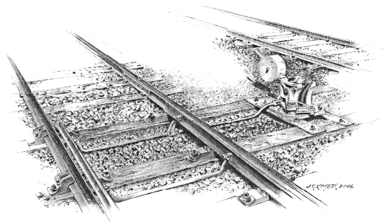

5. SIGNAL (1930s)
Each of the three arms has two positions—horizontal and downwards at 45°. These were the departure signals for the south, north and mainlines respectively. All were normally at ‘stop’ i.e. horizontal. When a Train Order was issued to proceed toward Hawker or Bruce the signal was 'pulled off' to 45° down for the line the train was waiting on. Each signal was interlocked with the switch end of the turnout (points) and confirmed that the track was correct for departure. At night, when the signal arm was moved, the position of the coloured glass relative to the lamp behind it changed, so the light showed red or green. Brackets to hold the three lamps can be seen and the lamps burned continuously, being refuelled weekly with kerosene. The lamp room (now gone) stood near the cream shed.
6. OVERHEAD TANK (originally 1879)
Water was pumped from the railway dam (Item 16) up to the overhead tank, which still carries advertising of the period. The steam locomotives were easily filled with water via the trunk (spout) on one side. The tank has a capacity of 25 000 gallons or 115 000 litres and was built from cast iron plates bolted together. This tank replaces, but is identical with, the 1879 tank.
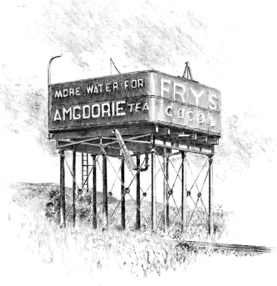
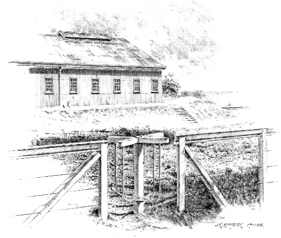
7. TURNSTILE (1880s)
This simple structure allowed pedestrians through the fence but kept stray stock out. There are others around the perimeter of the Station, which are still in use. After refreshment and entertainment at the hostelries in Railway Terrace, train crews could return to the kitchen and barracks via this convenient gate.
8. KITCHEN (1880) AND BARRACKS (1895/1940s)
Train crews had to provide their own meals, but these quarters provided facilities for cooking, bathing and sleeping, originally all in the small stone building. The later barracks building is of interest because it is built out of pressed concrete blocks—a construction innovation at that time.
9. RUNNING SHED (1879)
Originally this shed was where all locomotive servicing was carried out, but in the mid-1880s this function was transferred to new workshops off Stokes Terrace. Later, sleeping and dining cars for the Central Australia Railway were kept here and it became known as the ‘carriage shed’ or ‘car barn’.
10. STOCKYARDS (1879)
Movement of stock was the most significant freight activity. For sheep there were two decks in each car, with gates and ramps between the cars to allow stock to move forward down the train during loading. These were closed to secure the stock when loading was complete, additional hurdles being used where necessary to separate consignments. Some stock cars are in the station yard and the gates and ramps can be seen. In the interests of hygiene stock cars had to be cleaned after use and concern for the well-being of stock was expressed in the instruction ‘The quickest possible transit must be given to livestock’.
11. SILO (1963)
The silo stands on the site of the wheat stacks, where bags of grain were stacked while awaiting shipment by rail to flour mills. Both the Quorn mills had closed by the early 1900s. This 3000 ton silo was built in response to revised regulations for handling of grain. Quorn remains an important receival depot for grain grown in the southern Flinders Ranges. An adjacent bunker site, built in 1989/90, can be commissioned to cater for bumper harvests.

12. FIVE-TON CRANE (1879 and later)
Cranes were essential pieces of equipment for loading and unloading, hence its proximity to the goods shed. This one was the second, and its origins are unknown.
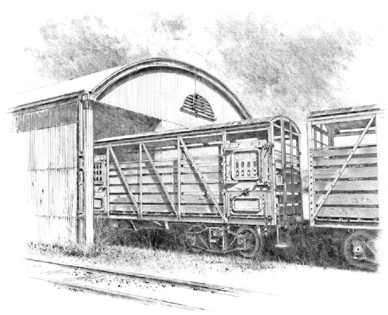
13. GOODS SHED (1879)
This provided covered and uncovered loading platforms and temporary storage for goods in transit. As the Station Master was the responsible agent for freight transport, the office maintained records of consignments and their receipt and despatch, the fees charged and also prepared destination labels for correct delivery.
14. WEIGHBRIDGE (1900)
The weight of loaded railway wagons needed to be monitored to avoid overloading and to provide information for billing the railway’s customers. The technical details are given in the sign. You will note that the weighbridge was made in the mid-north town of Kapunda by Hawke & Co Foundry. The weighbridge operates similarly to those at today’s roadside weigh stations where the load on each truck axle has to be measured.
15. PERMANENT OFFICE (1880)
Used as the Resident Engineer’s Office. The Engineer was responsible for the design construction and maintenance of tracks, bridges, culverts and buildings. The engineer’s requirements for safe operation of the railway could restrict the Chief Mechanical Engineer’s designs for locos and rolling stock.
16. RAILWAY DAM (1882)
Looking beyond the railway yard, across the road next to the Caravan Park is a grassy mound, which is a bank of the railway dam. Steam trains require substantial quantities of water and in semi-arid and arid areas assured supplies were an obvious concern. Supplies at Quorn were a case in point. In the early years water was piped from springs and wells in Pinkerton Creek. The dam, unfortunately accumulated run-off silt from the creek. When the Mount Arden Reservoir, some 5 km north of Quorn was completed in 1895 to supply the town, an allocation had to be made to the railway.
17. GANG (TROLLEY) SHED (1880)
This was the home base for the track gang responsible for the track between Quorn and Summit (en route to Woolshed Flat). The track inspection trolleys were also stored in this building. In the early days the trolleys would have been moved along the track by hand-operated levers, but this system was replaced (no doubt to the relief of the gangs) as small petrol engines were developed (see the sign for details).
18. RAILWAY HOUSES (c 1880)
There were three timber houses in this location and only one remains, which you can see from a distance (privately owned). Originally, there was the Resident Engineer’s house and two workmen’s cottages. They were built of timber in a similar style to the original station, but over the years two of them succumbed to the attention of termites.
19. COWAN’S SIDING (1879)
Private sidings ran to both Cowan’s Flour Mill and Dunn’s Flour Mill on Railway Terrace for handling consignments of grain and flour. The curved alignment to Cowan’s can still be seen. When the mill became a butter factory the owners allowed the British Imperial Oil depot behind them to use the siding, and later it was used to deliver fuel oil to the powerhouse.
20. OLD ELECTRICITY POWERHOUSE (1922)
This building housed the generator(s) which provided Quorn with electricity prior to connection to the statewide grid in about 1980. Power had earlier been supplied to the Railway Station in 1917 from a small independent generator.
21. COUNTRY WOMEN’S ASSOCIATION HUT (1942)
This was built by the Army for the provision of meals by the Army Service Corps Canteen. The requirement for meals outgrew the hut and the CWA resumed its original undertaking for serving meals in the Memorial Hall located at Quorn Oval. CWA purchased the hut in 1946. It is now owned by the Pichi Richi Railway Preservation Society for its members’ use.
Prepare for your walk
- Wear comfortable shoes
- Wear cool clothing in summer
- Wear a hat and sunscreen
- Be prepared to stop for a drink
- Read your notes before you set out so that you are clear where you start and where you are going
- Because there are uneven surfaces, look carefully where you put your feet
- Keep an eye open for lizards and snakes sunning themselves
LOOK OUT FOR TRAINS AT ALL TIMES
Sources:
Babbage J and Barrington R (1984) The History of Pichi Richi Railway
David Dawson Architects (2003) Draft Quorn Railway Station Conservation Management Plan
Dept of Environment & Natural Resources (1995) Flinders Ranges Heritage Survey Vol 3 Kanyaka/Quorn
McColl M (1993) A Salute to Quorn
Members of Pichi Pichi Railway Preservation Society Inc. kindly supplied notes and advice
Illustrations: J.R. Kimber


You might also be interested in the Quorn Town Heritage Walk. For information about other walks see the Flinders Ranges Council's Walks and lookouts page.
